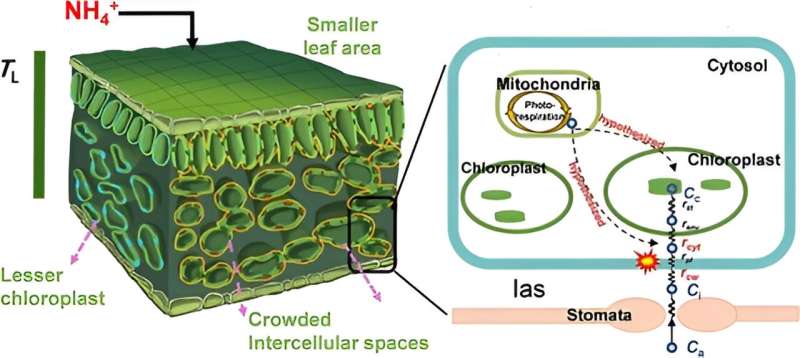This article has been reviewed according to Science X's editorial process and policies. Editors have highlighted the following attributes while ensuring the content's credibility:
fact-checked
peer-reviewed publication
trusted source
proofread
From roots to leaves: The nitrogen connection to photosynthetic efficiency

Photosynthesis efficiency in plants is influenced by the type of nitrogen absorbed. Ammonium (NH4+) and nitrate (NO3-) are the primary nitrogen sources, each affecting plant physiology differently. Variations in leaf anatomy, such as cell wall thickness and chloroplast number, play a crucial role in these processes.
Due to these challenges, there is a need to conduct in-depth research on the impact of nitrogen forms on leaf anatomical traits and photosynthesis.
The research conducted by a team from Nanjing Agricultural University and Huazhong Agricultural University, published on February 22, 2024, in Horticulture Research, explores the physiological mechanisms by which different nitrogen forms affect photosynthesis in Lonicera japonica. The study aims to quantify the limitations on photosynthesis imposed by various leaf anatomical traits under different nitrogen nutrition conditions.
The study reveals that NH4+ nutrition leads to significantly lower photosynthesis compared to NO3- or mixed nitrogen sources. This reduction is primarily due to a decrease in mesophyll conductance (gm), which is associated with thicker cell walls and fewer chloroplasts.
Pathway analysis indicates that increased lignin and hemicellulose content under NH4+ nutrition negatively impacts gm. Additionally, NH4+ nutrition reduces the volume of intercellular air space and increases cell wall thickness, further restricting CO2 diffusion.
These findings highlight the crucial role of leaf anatomical variations in regulating photosynthesis. Understanding these interactions provides valuable insights for improving nitrogen use efficiency in agriculture, emphasizing the need to optimize nitrogen for applications to enhance photosynthesis and plant growth.
Dr. Yong Li from Huazhong Agricultural University notes, "This study highlights the complex interactions between nitrogen forms and leaf anatomy, shedding light on how specific nitrogen sources can optimize photosynthesis. These insights are crucial for developing more efficient fertilization strategies in crop production."
The findings suggest that optimizing nitrogen form applications can enhance photosynthesis and plant growth, particularly in crops like Lonicera japonica. By understanding the specific impacts of NH4+ and NO3- on leaf anatomy, farmers and agronomists can tailor fertilization practices to improve nitrogen use efficiency, reduce environmental impact, and increase crop yields.
This research paves the way for future studies on the interplay between nitrogen forms and plant physiology, potentially leading to more sustainable agricultural practices.
More information: Yiwen Cao et al, Variation of mesophyll conductance mediated by nitrogen form is related to changes in cell wall property and chloroplast number, Horticulture Research (2024). DOI: 10.1093/hr/uhae112
Journal information: Horticulture Research
Provided by NanJing Agricultural University



















